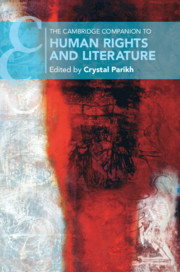Book contents
- The Cambridge Companion to Human Rights and Literature
- The Cambridge Companion to Human Rights and Literature
- Copyright page
- Epigraph
- Contents
- Notes on Contributors
- Chronology of Major Works and Events, 1215–2018
- Introduction
- Part I Genealogies and Contexts
- Part II Fashioning Methods
- 5 Law and Literature, the Procedural and the Performative
- 6 Human Rights Modes and Media
- 7 Remembering the Forgetting
- 8 Queering Human Rights
- Part III Generic Representations
- Part IV Writing Human Rights
- Select Bibliography
- Index
- Cambridge Companions To …
8 - Queering Human Rights
The Transgender Child
from Part II - Fashioning Methods
Published online by Cambridge University Press: 24 June 2019
- The Cambridge Companion to Human Rights and Literature
- The Cambridge Companion to Human Rights and Literature
- Copyright page
- Epigraph
- Contents
- Notes on Contributors
- Chronology of Major Works and Events, 1215–2018
- Introduction
- Part I Genealogies and Contexts
- Part II Fashioning Methods
- 5 Law and Literature, the Procedural and the Performative
- 6 Human Rights Modes and Media
- 7 Remembering the Forgetting
- 8 Queering Human Rights
- Part III Generic Representations
- Part IV Writing Human Rights
- Select Bibliography
- Index
- Cambridge Companions To …
Summary
This chapter looks at the proliferation and pluralization of the subject of human rights, in terms of identity and difference, in the twentieth century, with its inclusion of previously elided constituencies – women, LGBTQ individuals, persons with disabilities, migrants, and so on. The authors test the limits of this plurality by studying its imbrication with heteronormative notions of reproductive futurism, transnormativity, ableism, and neoliberal agency. The texts in consideration are three documentary films – Growing up Coy, Born in the Wrong Body: My Transgender Kidand Kids on the Edge: the Gender Clinic. This chapter seeks to understand the potentialities and limitations of transformative identity-based legal categories, and the children whose personal lives are derecognized within the systems of these categories, and also to ‘queer’ or ‘crip’ established human rights discourses which have their roots in heterosexist notions of ownership of one's body.
- Type
- Chapter
- Information
- The Cambridge Companion to Human Rights and Literature , pp. 114 - 126Publisher: Cambridge University PressPrint publication year: 2019

